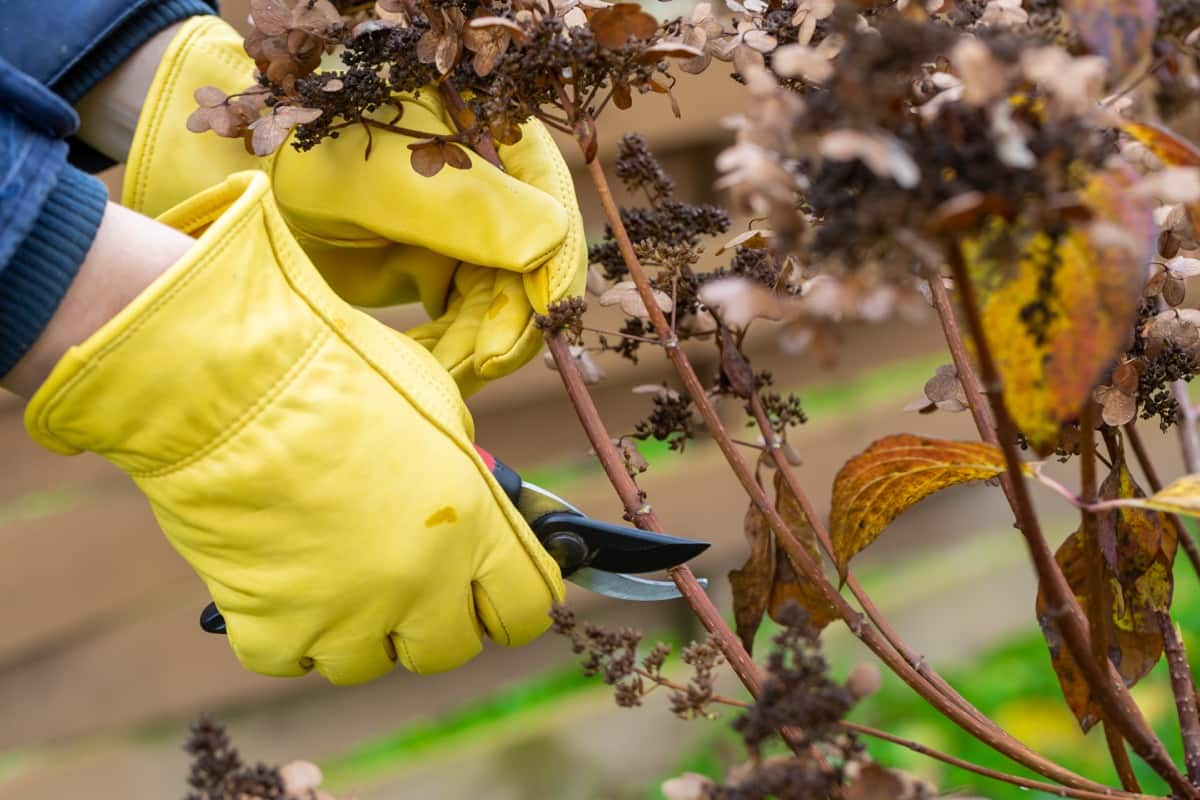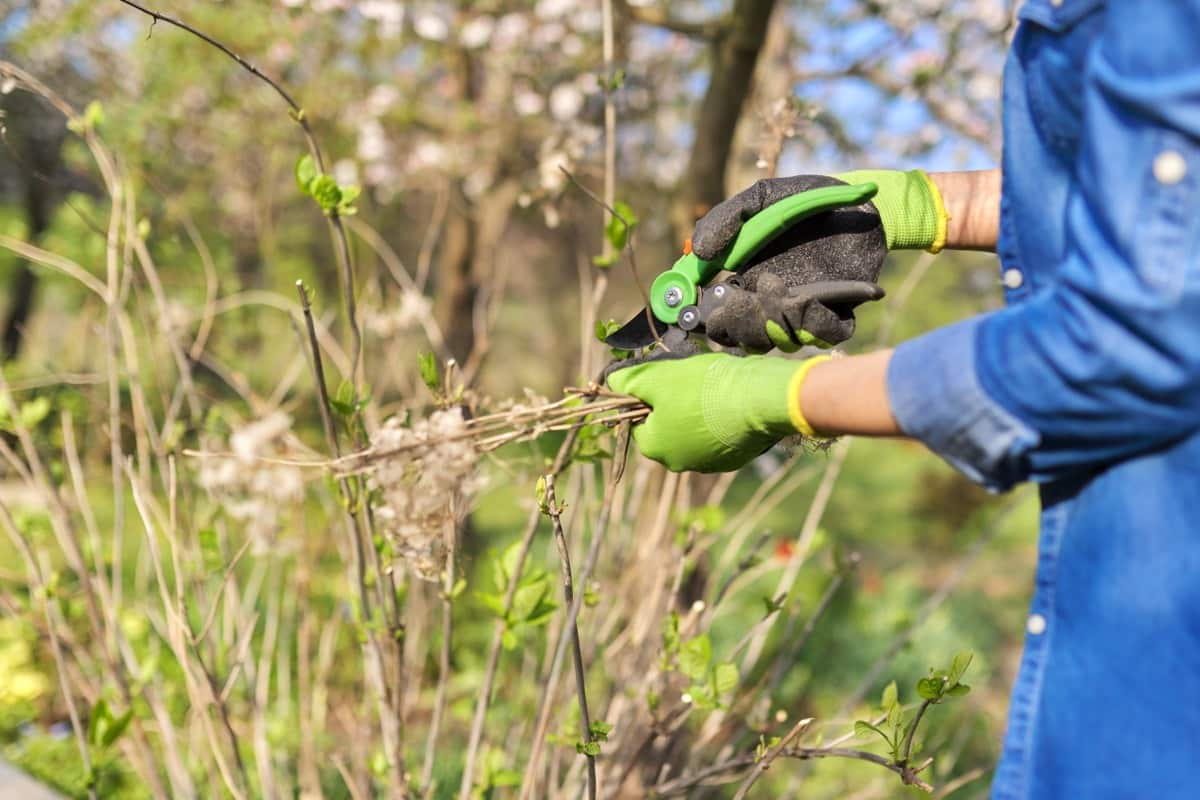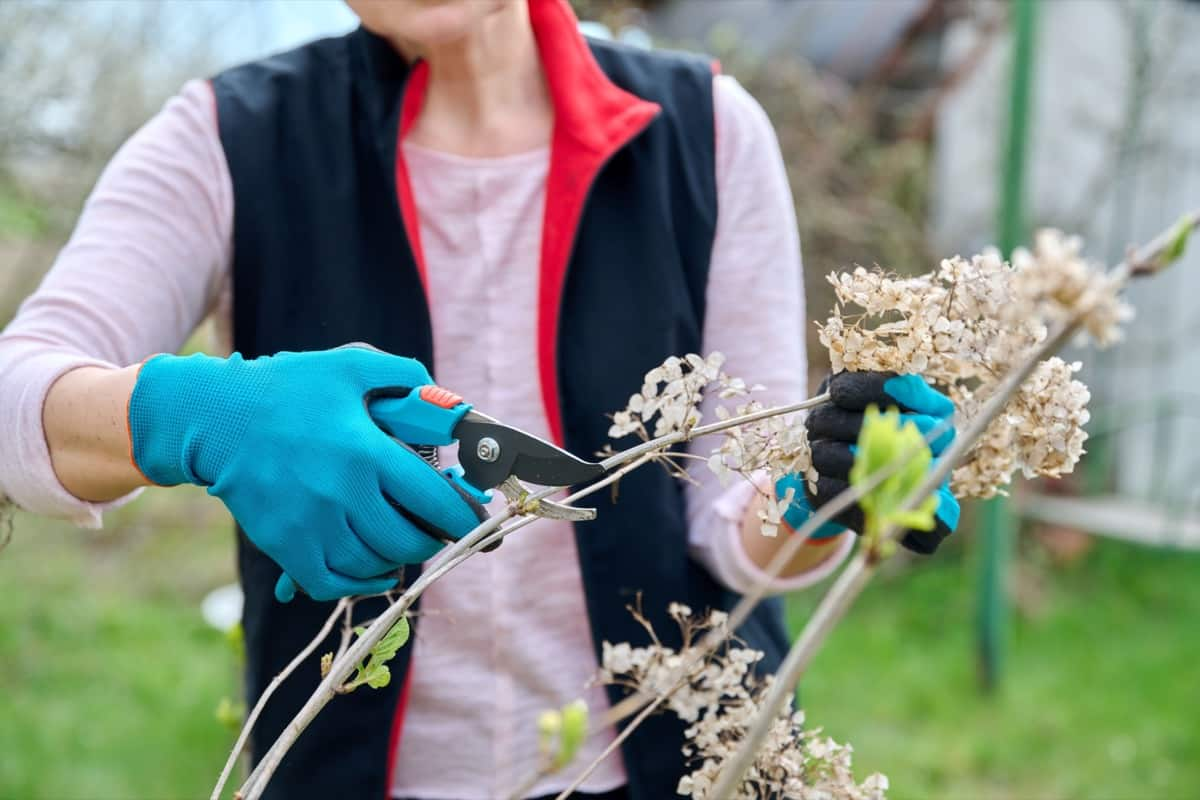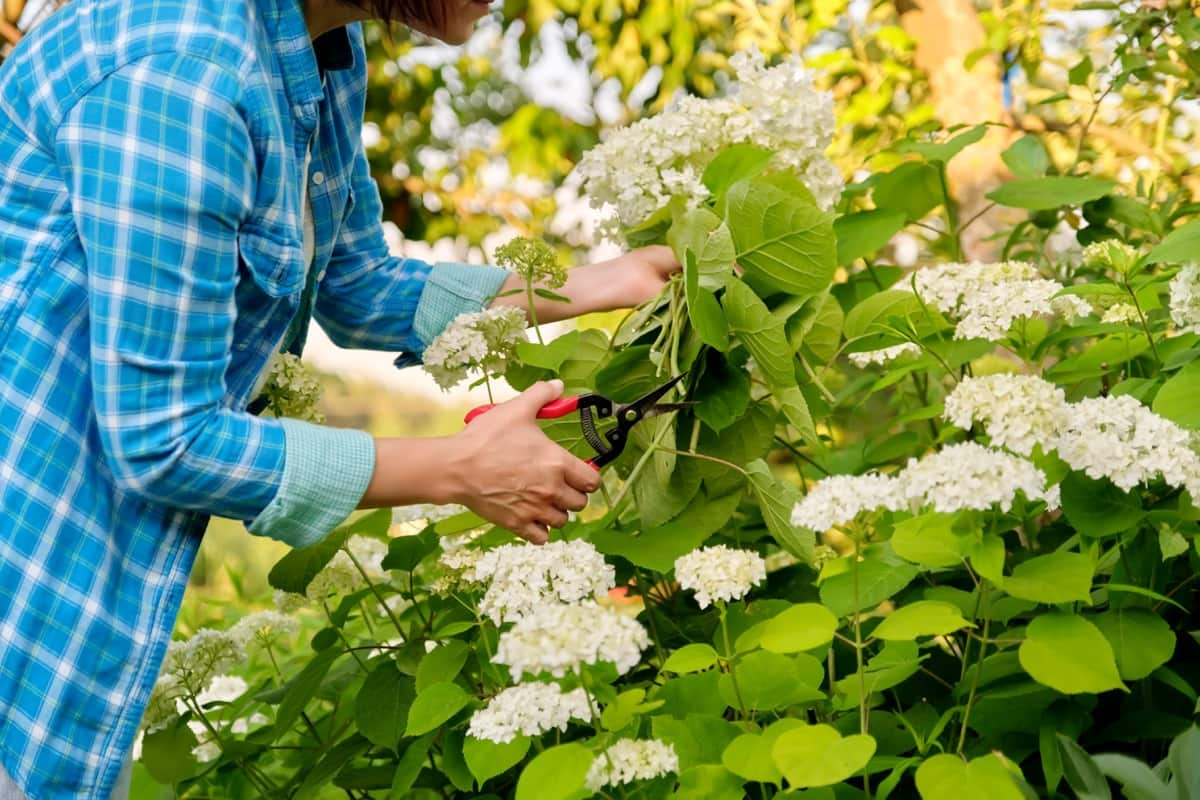Hydrangeas are a beautiful addition to any garden, but without proper pruning and care, they can quickly become overgrown and unmanageable. Hydrangeas are flowering shrubs that can be found in many gardens. Hydrangeas are known for their large, showy flowers and ability to tolerate various climates.

Hydrangeas come in many colors: white, pink, blue, and purple. Pruning Hydrangeas can be daunting, but it’s important to keep up with pruning to keep them looking their best. If you have ever seen a Hydrangea bush, you know that it can get pretty big. And if you have ever tried to prune one, you know that it can be pretty tricky.
When to Prune Hydrangea Varieties
Types of Hydrangeas
Bigleaf Hydrangea
As their name suggests, bigleaf Hydrangeas have large leaves measuring up to 8 inches long. Their flowers are also much larger than other types of Hydrangeas, and they can range from white to pink to blue.
Panicle Hydrangea
Panicle Hydrangeas are a type of Hydrangea. They are characterized by their large, cone-shaped flower clusters that can range in color from white to pink to purple. Panicle Hydrangeas are hardy plants that tolerate colder temperatures and thrive in full sun or partial shade.
Smooth Hydrangeas
Hydrangeas are one of the most popular types of flowers due to their large, showy blooms. There are many different species of Hydrangeas. Hydrangeas come in various colors, including white, pink, purple, and blue. The color of the Hydrangea flower depends on the type of soil it is grown in. Hydrangeas are relatively easy to care for and make a great addition to any garden.
In case you missed it: How to Grow and Care for Hydrangeas: A Beginners Guide to Planting to Harvesting

Oakleaf Hydrangeas
Hydrangeas are the most popular flowering shrubs, and oakleaf Hydrangeas are a stunning variety. Oakleaf Hydrangeas get their name from their large, deeply lobed leaves, resembling an oak tree. The leaves are a beautiful deep green in the summer before turning a rich burgundy-red in the fall. And, of course, the show’s star is the clusters of white or pink flowers that appear in late spring or early summer. If you’re looking for a Hydrangea that will make a statement in your garden, an oakleaf variety is worth considering.
Climbing Hydrangeas
Climbing Hydrangeas are a type of Hydrangea plant specifically grown to climb up walls, trellises, and other structures. While they can technically be left to grow independently, pruning and training climbing Hydrangeas will result in a more aesthetically pleasing plant. Climbing Hydrangeas are relatively easy to care for. They prefer partial sun to full shade and moist, well-drained soil. Once established, they are drought tolerant. It is important to water regularly during the first growing season to encourage root development. Fertilize in early spring with a balanced fertilizer.
Why and When to Prune Your Hydrangeas?
Pruning Hydrangeas is important to keep these beautiful plants healthy and vigorous. There are a few different reasons why you would want to prune your Hydrangeas, and the best time to do so depends on the type of plant. Hydrangeas bloom on new wood (such as panicle and smooth Hydrangeas) and should be pruned in late winter or early spring before new growth begins. This will ensure the plant has plenty of time to produce new flowers for the season. Pruning too late in the season can also reduce the number of blooms for next year.
On the other hand, Hydrangeas that bloom on old wood (like bigleaf and oakleaf Hydrangeas) should only be pruned after they have flowered. Pruning before they flower can result in fewer or no blooms. If you wait until after they flower, you can remove dead or damaged branches and branches crossing or rubbing against each other. Pruning Hydrangeas is important to maintaining healthy plants and keeping them looking their best.
By carefully considering which variety you have, when to prune it, and how to do it properly, you can ensure that your Hydrangea will remain in good condition for years. With a little knowledge and care, you can enjoy the beauty of these spectacular plants without any headaches. These plants are relatively low-maintenance, so you don’t need to be overly aggressive with your pruning.
In case you missed it: How to Grow Ghost Peppers from Seed: At Home, in Pots, Raised Beds, Terrace, and Backyard

Tips to Prune Bigleaf Hydrangea
Deadhead Spent Flowers
Regularly removing spent flowers is important to keep your bigleaf Hydrangea blooming at its best. This process, called deadheading, not only encourages new growth and more flowers but also helps to keep the plant tidy and looking its best. Cut off the stem below the flower head with pruning shears to deadhead spent flowers.
You can either dispose of the stem or leave it on the ground near the base of the plant, where it will eventually decompose and provide nutrients for the roots. After deadheading, look at your plant’s overall shape and prune any stray or leggy stems to promote fullness and encourage new growth.
Prune Away Dead and Weak Stems
If your bigleaf Hydrangea looks a little worse for wear, it may be time to give it a good pruning. Pruning helps to encourage new growth and can also help to shape the plant. When pruning, be sure to remove any dead or weak stems. These stems will not produce new growth and can harm the plant if left in place.
Prune for Size
Pruning bigleaf Hydrangea is best done in late winter or early spring before new growth begins. You can prune to reduce the plant’s size, remove damaged or diseased stems, or shape the plant. When pruning to reduce the size, cut back all stems by one-third to one-half their length.
Tips to Prune Smooth Hydrangea
Remove Dead or Injured Branches
If you notice any dead or injured branches on your smooth Hydrangea, removing them as soon as possible is important. Dead branches can harbor pests and diseases that can spread to other parts of the plant, and injured branches are more likely to break off and fall, which could damage the rest of the plant. To remove a dead or injured branch, use sharp pruning shears to make a clean cut above a healthy bud or branch. Cut the branch back to the main stem if no healthy buds or branches are nearby.
In case you missed it: Top 21 Best Flowers for Bees

Trim for Shape
If you want to achieve a certain shape with your smooth Hydrangea, then you must trim it. The best time to do this is in late summer or early fall. Start by pruning away any dead or diseased wood. This will help improve air circulation and prevent the spread of disease. Next, cut back any shoots that are growing out of bounds. Up to two-thirds of their length can trim back. Finally, prune away any straggly or leggy growth. This will help improve the overall shape and appearance of your plant.
Prune Hard for Large Flowers
You should prune your smooth Hydrangea several times yearly to keep it looking its best. First, remove any dead or diseased stems. Next, cut back the remaining stems by one-third to one-half their length. Be sure to make your cuts at an angle so that water can drain off easily. Finally, thin out the center of the plant to promote air circulation and prevent disease.
Tips to Prune Panicle (Peegee) Hydrangea
Deadhead Spent Flowers
First, to deadhead spent flowers on a panicle Hydrangea, identify the stems that have finished blooming. These will be the stems that are brown and woody in appearance. Using pruning shears, cut the stem to a point just above where new growth emerges. Repeat this process throughout the season as needed to keep your plant looking its best.
Prune Lightly to Maintain the Shape
When pruning panicle Hydrangeas, it’s best to err on the side of caution. These shrubs are vigorous growers and can quickly become overgrown if improperly maintained. Prune lightly after each bloom cycle to keep your panicle Hydrangea in shape. This will encourage new growth and help to keep the shrub from becoming too leggy.
Do Hard Pruning in Late Winter
When pruning panicle Hydrangeas, the best time is late winter or early spring. This will give the plant ample time to recover from damage during pruning and encourage new growth. When pruning, be sure to remove any dead or dying branches first. Then, cut back any remaining branches by about one-third of their total length. This will help promote fresh growth and prevent the plant from becoming too leggy.
Remove Dead Stems in Early Spring
Removing dead or dying stems in early spring is essential to keeping your panicle Hydrangea healthy and looking its best. Doing this will also help encourage new growth. To remove dead or dying stems, use sharp pruning shears to cut them back to the point where they branch off from a live stem. Make your cuts at a 45-degree angle so that water can drain away from the cuts.
In case you missed it: How to Grow and Care for Dieffenbachia (Dumb Cane) Plant Indoors: A Beginners Guide

Prune for Shape
To prune for shape, first identify the main stems of the plant. These are the thickest, longest branches that extend upwards from the base of the plant. Cut away any smaller branches that grow from the main stems. Next, identify any crossed or rubbing branches and prune these away as well. Finally, cut away any branches growing towards the center of the plant.
Tips to Prune Climbing Hydrangeas
Prune to Control Size
To control the size of climbing Hydrangeas, prune them annually in late winter or early spring. Cut back the previous year’s growth by one-third to one-half, removing any weak or spindly stems.
Special Pruning to Rejuvenate a Neglected Plant
If your climbing Hydrangea looks neglected, you can rejuvenate it with special pruning. First, remove any dead or diseased wood. Then, cut back all the stems to about 6-12 inches from the ground. This may seem drastic, but the plant will quickly return with new growth. Finally, thin out any crowded or crossing stems to allow light and air to reach the center of the plant.
Tips to Prune Oakleaf Hydrangeas
Prune Out Winter Dieback
As soon as the blooms fade on your oakleaf Hydrangea, it’s time to do some pruning. First, remove any stems that are dead, dying, or diseased. Cut these stems back to healthy wood. Next, thin out the plant by removing some of the older stems down to the ground. This will boost new growth and prevent the plant from becoming too dense and top-heavy. Finally, cut back any long or wayward stems to tidy up the plant and promote air circulation.
Prune for Shape
Remove any dead, damaged, or diseased wood to prune for shape. Next, remove any crossing or rubbing branches. Finally, cut back the remaining branches to the desired length and shape.
In case you missed it: How to Grow and Care for Primrose in the Backyard

Conclusion
Pruning Hydrangeas is a simple yet essential part of gardening. With the right tools and techniques, you can achieve beautiful results that will last for years. Hydrangea pruning doesn’t have to be intimidating; it’s quite easy once you know what to do and when. Pruning climbing Hydrangeas is a simple process requiring no special tools or knowledge. You must remove the dead or diseased wood and cut back the remaining stems to encourage new growth. With a bit of care, your climbing Hydrangeas will thrive and produce abundant beautiful blooms.
- Cabbage Seed Germination and Selection
- Broccoli Seed Germination and Selection
- Asparagus Seed Germination and Variety Selection
- Seasonal Flower Gardening: Best Practices for Spring, Summer, Fall, and Winter
- How to Grow Hibiscus from Flower
- Plantation Ideas for Home Decoration: A Beginners Guide
- Flower Garden Designs and Layouts for Beginners
- Planting and Spacing Techniques in Papaya: A Beginner’s Guide
- Growing Gold: Essential Techniques for Planting Pineapples
- How to Make Kalanchoe Plant Bushy: Home Remedies and Solutions
- 11 Reasons Why Your Gardenia is Not Blooming: Home Remedies and Solutions
- Eco Elegance: The Guide to Designing a Drought-Tolerant Landscape
- Gardening on a Slope: Strategies for Hillside Landscaping
- Nourish and Flourish: Top Organic Mulches for Thriving House Plants
- Everything You Want to Know about Indian Mogra Flower: Discover Uses and Growing
- Green Thumb Success: Expert Tips for Cultivating Greenhouse Pumpkins All Year Round
- Maximize Growth & Flavor: The Ultimate Guide to Companion Planting in Herb Gardens
- How to Control Rhododendron Problems Naturally: Home Remedies and Organic Ways to Fix Them
- Natural Magic: The Remarkable Benefits of Cinnamon for Plants
- Best Steps to Revive Dying Tulip with Natural and Organic Treatment
- 10 Reasons Why Your Angel Trumpet is Not Blooming: Remedies and Treatment
- How to Fix Periwinkle Leaf and Flower-Related Problems: Natural Remedies and Solutions
- How to Fix Zinnias Leaf and Flower Problems: Discover Natural and Home Remedies
- Organic Steps to Induce Lemon Tree Flowers: A Comprehensive Guide
- Bloom Booster: Crafting the Perfect Homemade Bougainvillea Fertilizer
- Optimizing Growth: A Guide to Applying NPK Fertilizer for Potted Plants
- 10 Best Homemade Fertilizers for Rubber Plant: DIY Recipes and Application Method
- How to Boost Female Pumpkin Flowers: Effective Steps for More Flowers and High Yields
- Transform Your Indoor Garden: Top Benefits of Pink Salt for Houseplants
- 10 Best Homemade Fertilizers for Peacock Plants (Calathea): Easy DIY Guide
- Unlock Blooms: 9 Reasons Why Your Potted Chrysanthemum is Not Blooming
- 8 Reasons Why Your Potted Hibiscus is Not Blooming: Fix it with Simple Solutions
- Unlock Blooms: 9 Key Reasons Your Potted Frangipani Won’t Flower
- 10 Reasons Why Is My Ice Plant Not Blooming: Remedies and Treatment
- 10 Reasons Why My Potted Hydrangea Not Blooming: Treatment and Remedies
- 10 Reasons Why is My Wisteria Not Blooming: Remedies and Treatment